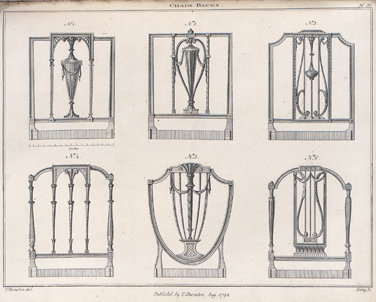Thomas Sheraton 1751-1806, English designer of furniture and author. He may have been apprenticed to a cabinetmaker, and as an earnest Baptist he wrote religious books and preached. Records show that he was in London from c.1790 and supplemented the meager earnings from his books by giving drawing lessons. Although he may have supervised the making of some furniture, his designs became influential through his manuals, especially the Cabinet-Maker and Upholsterer's Drawing-Book (1791-94). Sheraton's style is marked by a graceful delicacy and simplicity, emphasis on straight, vertical lines, and a preference for inlay decoration, reeded legs, and classical motifs. He is also the author of The Cabinet Dictionary (1803).

Bibliography: See R. Fastnedge, Sheraton Furniture (1962).
"Thomas Sheraton." The Columbia Encyclopedia, Sixth Edition. 2008. Encyclopedia.com. 27 Jan. 2010 <http://www.encyclopedia.com>.
Sheraton style furniture was remarkable for its refined elegance, excellent proportions and balanced distribution of ornaments. It also mirrored the influence of Robert Adam and the Louis XVI style, which Thomas Sheraton greatly admired.
Curved lines were to a great extend abandoned, in favor for the straight line, and his designs were essentially rectangular with emphasis on the vertical lines. However, Thomas Sheraton still showed a preference for curved lines in his glazing bars and oval panels.
His later designs incorporated certain features of the French Directoire and French Empire styles. Some of the drawings in the Directoire taste frequently had many pleasing qualities but they did not match the high level of design found in his early work.
Legs

Thomas Sheraton used straight tapering legs of either quadrangular or cylindrical form. The cylindrical tapered legs were often vertically fluted or reeded and sometimes spirally turned. The legs were often finished with brass toe caps and wheel casters. The quadrangular leg often terminated in a spade foot. Occasionally the legs were joined with stretchers.
Woods and Veneer
Sheraton continued to recommend the same woods preferred by Adam and Hepplewhite. Golden-toned satinwood was extensively used on Sheraton style furniture. Sheraton stated that he liked its "cool, light and pleasing effect in furniture".
 The veneer was carefully selected to show the greatest amount of figure. Richly toned satinwood and mahogany veneered surfaces were freely inlaid with decorative bandings and borders of contrasting woods, such as rosewood, kingwood, tulipwood, satinwood, hare wood and mahogany.
The veneer was carefully selected to show the greatest amount of figure. Richly toned satinwood and mahogany veneered surfaces were freely inlaid with decorative bandings and borders of contrasting woods, such as rosewood, kingwood, tulipwood, satinwood, hare wood and mahogany.
Mahogany was still a popular wood for library and dining room furniture as well as for general household articles as chests of drawers and wardrobes. It was principally used as a veneer; however, when a surface was to be enriched with carving it was also used in the solid.
Delicate decorative stringing lines also frequently appeared on border bandings and on the legs of chairs and tables. Doors on china cabinets, sideboards and other similar pieces were often inlaid with oval or circular stringing lines.
Gilding
Thomas Sheraton was partial to gilding. His illustrations for drawing room chairs and settees designed in the contemporary French taste were usually either entirely gilded or painted. He said that the painted examples should be partially gilded to "give a lively effect". He preferred an entirely white ground with gilt enrichments. Torchères and the pier table were usually gilded except for its satinwood top.
Painting

Sheraton illustrated in his DRAWING BOOK exquisitely painted border designs for pier tables. He also showed finely painted oval medallions of classical figure subjects as well as other Neo-Classic ornament appropriate for use in painted panels.
Japanned beech-wood chairs and settees were also a characteristic of Sheraton style furniture. They were generally japanned in lamp black enriched with painted decoration either in polychrome or en grisaille. The top rail of the chairs and settees often centered a painted oblong tablet. This inexpensive painted furniture was colorful and it satisfied the prevailing fashionable taste for rich color effects.
Marquetry
Thomas Sheraton displayed a preference for decorating his more elegant satinwood cabinetwork, such as chairs, commodes and pier tables, with marquetry. Sheratons style of ornament to be carried out in marquetry was spirited and graceful and displayed exquisite detail in its composition.
Motifs

Sheraton style motifs were interpreted in a light and spirited manner. The principle of symmetry was carefully observed both in the composition and in the distribution of ornament, giving the designs a faultless balance. The ornament included the classical motifs developed by Robert Adam and the prevailing motifs of the Louis XVI style.
Included among the fashionable and favorite motifs were:
fans, shells, rosettes, segmental Paterae, paterae filled with rosettes, the water leaf motif, delicate acanthus scrolling, foliage scrolls, the lyre motif, three Prince of Wales feathers, urns of blossoms, slender and graceful classic urns often decorated with festooning, the vase motif, honeysuckle or the anthemion, drapery swags, lozenges, delicate pendants or festoons of husks, graceful floral or drapery festoons, entwined floral garlands, pendants of flowers, wreaths of flowers, bowknotted baskets of flowers, interlacing vine trails, and medallions of classical figure subjects.